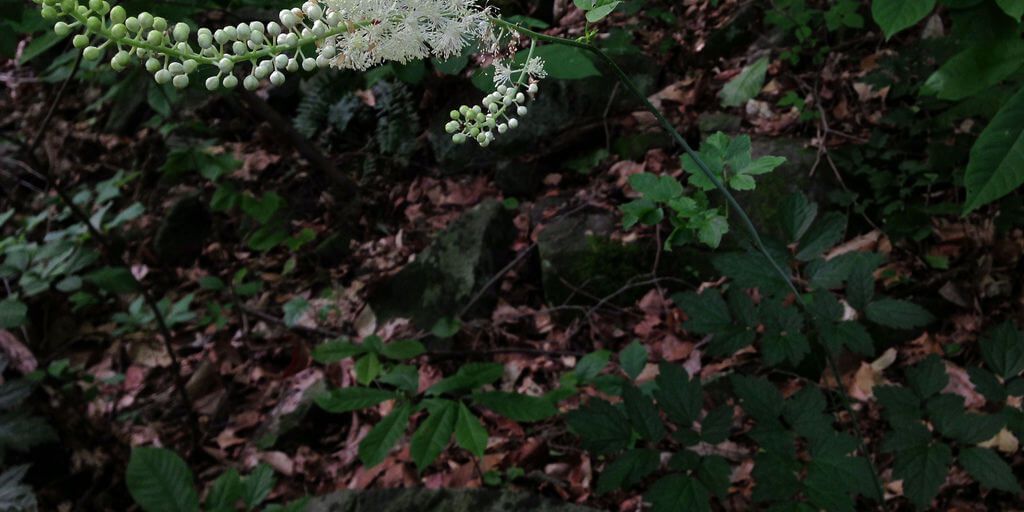Black cohosh, Actaea racemosa, (formerly known as Cimicifuga racemosa), is a perennial herb native to eastern North America. It belongs to the Ranunculaceae family and is also commonly known as black snakeroot, bugbane or rattleroot.
History of Black Cohosh Use
Black Cohosh has been used by Native Americans for more than two hundred years, after they discovered the root of the plant helped relieve menstrual cramps and symptoms of menopause. “Native Americans used the roots and rhizomes of this member of the buttercup family to treat kidney ailments, malaria, rheumatism and sore throats.
Early American settlers turned to it for bronchitis, dropsy, fever, hysteria and nervous disorders, lumbago, rattlesnake bites and yellow fever. It’s also reportedly well known for easing PMS and menstrual irregularities.”
These days it is still used for menopausal symptoms such as hot flashes/flushes, irritability, mood swings and sleep disturbances. It is also used for PMS, menstrual irregularities, uterine spasms and has been indicated for reducing inflammation associated with osteoarthritis, rheumatoid arthritis and neuralgia.
Black Cohosh Reduces Menopausal Symptoms
Herbal researcher Dr. James Duke has this to say about Black Cohosh; “Black Cohosh really should be better known in this country, especially with our aging population and the millions of women who are now facing menopause. Recognized for its mild sedative and anti-inflammatory activity, Black Cohosh can help with hot flashes and other symptoms associated with that dramatic change of life called menopause. It’s also reported to have some estrogenic activity.
Herbalist Steven Foster refers to a study that compared the effects of conventional estrogen replacement therapy with Black Cohosh. That study looked at 60 women, younger than 40 years old, who had had complete hysterectomies and were experiencing abrupt menopause. In all groups, treatment with Black Cohosh compared favorably with conventional treatment.”
This estrogenic activity, notes Dr. Duke, can contribute to a ‘mastogenic’ effect; the natural enlargement of the breasts. Black Cohosh has also been used to induce labour and should not be used during pregnancy.
Black Cohosh Research
A dozen studies or more conducted throughout the 1980s and 1990s confirm that the long-standing use of Black Cohosh for menopausal symptoms has scientific validity. For example, in a German study involving 629 women, Black Cohosh improved physical and psychological menopausal symptoms in more than 80% of the participants within four weeks.
In a second study, 60 menopausal women were given Black Cohosh extract, conjugated estrogens, or diazepam (a leading anti-anxiety medication) for three months. Those who received Black Cohosh reported feeling significantly less depressed and anxious than those who received either estrogens or diazepam.
In another study, 80 menopausal women were treated for 12 weeks with Black Cohosh extract, conjugated estrogens, or placebo. Black Cohosh improved anxiety, menopause and vaginal symptoms. In addition, the number of hot flashes dropped from 5 to less than 1 average daily occurrences in the Black Cohosh group compared to those taking estrogen in whom hot flashes dropped from 5 to 3.5 daily occurrences.
Given these examples, and results of other studies, some experts have concluded that Black Cohosh may be a safe and effective alternative to estrogen replacement therapy (ERT) for women who cannot or will not take ERT for menopause (also known as Hormone Replacement Therapy or HRT).
Preliminary studies also suggest that Black Cohosh may help reduce inflammation associated with osteoarthritis and rheumatoid arthritis. In a review of scientific studies, researchers concluded that a combination of Black Cohosh, Willow bark (Salix spp.), Sarsaparilla (Smilax spp.), Guaiacum (Guaiacum officinale) resin, and Poplar bark (Populus tremuloides) may help relieve symptoms of osteoarthritis.
Shopping
| Visit the new SHOPPING page for a wide selection of amazing products! |
Always take care when taking herbs and Read Our Disclaimer.
Black Cohosh Herb Notes / Side Effects
Black Cohosh has an estrogen-like effect, and women who are pregnant or lactating should not use the herb. Large doses of this herb may cause abdominal pain, nausea, headaches, and dizziness. Women taking estrogen therapy should consult a physician before using Black Cohosh.
Large doses of Black Cohosh cause symptoms of poisoning, particularly nausea and dizziness, and can also provoke miscarriage.
Black Cohosh should not be used by those who have full-blown measles or those who are having trouble breathing. It should also not be used by those with excess in the upper regions and deficiency in the lower part of the body.
Latin Names
Actaea racemosa L, Cimicifuga racemosa, Cimicifuga heracleifolia, Cimicifuga dahurica, Cimicifuga foetida
Common Names
Black Cohosh, Black Snakeroot, Bugbane, Squawroot, Bugwort, Rattleroot, Rattleweed, Richweed, Cimicifuga, Sheng ma, Chinese Black Cohosh
Suggested Properties of Black Cohosh
Mild sedative, relaxant and anti-inflammatory. Contains glycosides (sugar compounds), isoferulic acids and, possibly, phytoestrogens (plant based estrogens). Diaphoretic, antipyretic, antifungal and antibacterial.
Uses of Black Cohosh
Menopause – Hot flashes, irritability, mood swings and sleep disturbances PMS Menstrual irregularities Uterine spasms
Black Cohosh is Indicated for:
Reducing inflammation associated with osteoarthritis and rheumatoid arthritis. Neuralgia.



Leave a Reply